














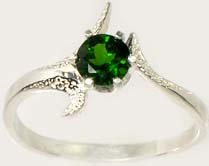
Excellent Quality Handcrafted Genuine Natural Siberian One-Half Carat Round Cut Faceted Forest Green “Yakutsk Emerald” (Chrome Diopside). Contemporary High Quality Sterling Silver Ring (Size 7 – Resizing Available).
CLASSIFICATION: Chrome Diopside Faceted Round.
ORIGIN: Siberia, late 1990’s.
SIZE: Diameter: 5mm. Depth: 3mm. All measurements approximate.
WEIGHT: 0.52 carats.
NOTE: Resizing is available. If you would prefer a different setting style, odds are we have many different setting styles available which would fit this stone(s) which could be substituted for no or very little additional cost. 14kt solid gold settings are also available. Write us for pictures and prices.
NOTE: If you would like only the gemstone, and not the setting, we can dismount the gemstone and offer you the gemstone without the setting. Just let us know, and yes, we’ll discount the price by the cost of the setting.
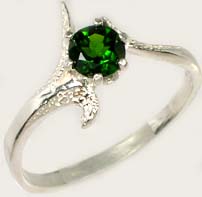
DETAIL: In Russia chrome diopside is known as “Yakutsk Emerald”, so named after the city nearest its source Yakutsk, a city just south of the Arctic Circle in Northern Siberia. In Russia chrome dopside is worn as a talisman with the belief that it brings good health to the wearer. It is also regarded as useful for relieving tired eyes and mental stress. In Russian folk medicine, wearing chrome diopside as an amulet is believed to prepare the body for heavy medications, predisposing the body to absorb the medications more completely and without side effects. Metaphysically it is said to bestow the wearer with a feeling of freedom and hopefulness. There are even specific prescriptions for the wearing of chrome diopside in the folklore of Russia.
Worn on the left hand, set into silver, it is said to be an aid to preventing or recovering from diseases involving the lungs and respiratory system. Worn on the right hand and set in gold, it is said to have a beneficial effect on stomach and digestive disorders. Finally, when worn on the left hand, it is said to engender a more appealing personality for the wearer, and is so recommended to wear on dates and on job interviews. Here is a gorgeous, richly colored forest green chrome diopside semi-precious gemstone which has been cut into a faceted round. This is a nice quality specimen no less than eye clean. The rich green color is due to trace amounts of the element chromium. Note the brilliance and flashy sparkle. Chrome diopside’s refractive index is twice that of emerald. The gemstone was hand crafted and faceted by a Russian artisan, part of a centuries-old heritage renown for the production of the elaborate gemstones and jewelry of the Czars of Medieval, Renaissance, and Victorian Russia.
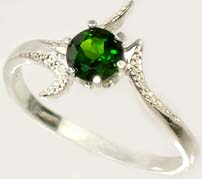
The setting is of contemporary origin. It is a high quality setting manufactured by one of the USA’s leading semi-custom mount producers. It is constructed of solid sterling silver. We do have the ability to have the ring sent out for resizing if requested. There are many other ring styles available, if you would like to see them, just contact us, we would be happy to share them with you. Most other setting styles in sterling silver are available at no additional cost. Additionally, if preferred, this mounting (as well as a wide variety of ring settings in other appealing styles) are also available in 14kt solid gold. As might be expected under magnification the gemstone shows the unmistakable characteristics of having been hand crafted. The coarseness of the handcrafted finish is considered appealing to most gemstone aficionados, and is not considered a detriment, or detract from the value of a gemstone. These characteristics are not only expected of hand-finished gemstones, many believe that such hand-crafted gemstones possess much greater character and appeal than today's mass-produced, laser-cut gemstones. Unlike today’s computer controlled machine produced gemstones that approach flawlessness in a perfect finish, the cut and finish of a handcrafted gemstone such as this is the cultural legacy passed onwards by artisans who lived centuries ago.
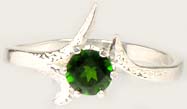
Handcrafted though it may be the gemstone possesses superb luster and sparkle, and to the eye is absolutely transparent, but one cannot say with absolute certainty that it is unconditionally flawless. True, the blemishes it possesses are not visible to the naked eye, and the gemstone can be characterized, to use trade jargon, as "eye clean". Even in these photo enlargements there are no discernible blemishes. To the eye it is indeed flawless; however were one to examine it in a jeweler’s loupe, it’s almost certain that a few minute blemishes could be detected. Of course the same may said about almost any natural gemstone. An absolutely flawless gemstone simply is not the rule in nature.
Unfortunately most absolutely flawless gemstones will upon close examination be revealed to be synthetic. You might also notice under magnification occasional irregularities in the cut and finish. Naturally these characteristics are absolutely to be expected with hand-finished gemstones. However for most, the unique nature and character of handcrafted gemstones such as this more than makes up for minute cutting or faceting blemishes, which by and large of course, are (if at all) only visible under high magnification.

DIOPSIDE HISTORY: Gemstone quality diopside is generally found in two varieties, black star diopside and chrome diopside (called “chrome” because trace amounts of the element chromium give chrome diopside its characteristic, rich green color). Star diopside is black or brown in color and is so named because it contains needle-like inclusions that reflects back light and produces a four-ray star on the surface known as an “asterism”, such as that found in star sapphire or star ruby. The gemstone is very abundant in India. Chrome diopside is the only transparent variety of diopside, and the only variety of diopside commonly considered “gemstone grade”. It is most often simply referred to as “diopside” in the trade, rather than “chrome diopside”.
Chrome diopside gemstones are very brilliant, with a lot of sparkle, due to very high refractive index, which is double that of the precious gemstone emerald. There are two other types of diopside which though generally not used in jewelry (as they are opaque) are considered “collectible” stones. There’s a purple type of diopside known as “violane” which is typically found in Italy. Then here is a light, yellow-green stone known as “tashmarine diopside” which is found in Uzbekistan. Diopside derives its name from the Greek “dis”, meaning "two kinds"; and opsis, meaning “faces”, or “appearances” (or “opinions”). Taken together it literally means that diopside has “two kinds of vision” or “two opinions”, or a “double appearance”. It is so named because when viewed from one side it exhibits one color, while from another side it appears differently. This phenomenon is known as “pleochroism”.
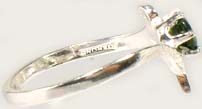
Chrome diopside is a very beautiful, sparkling gemstone, but due to the limited quantities in which it is produced has been overlooked for many years by the mainstream jewelry industry. There’s simply not enough supply to make it a worthwhile promotional project, and it is quite difficult to procure this stone. The area of Northern Siberia it is mined from is so rugged, and the winters so loing and bitter, that it only can be produced a few months of each year. Gemstones with an attractive pure green color are generally rare and very costly. Emerald is of course the most valuable and popular green gemstone. Tsavorite garnet and chrome tourmaline also have a rich green color but they are increasingly difficult to find and have become relatively expensive as a result.
Chrome diopside, every bit as beautiful as chrome tourmaline or tsavorite garnet, is found in commercially viable quantities only in the Russian Ural Mountains of Siberia. Given the significance and prominence of this source, it is not surprising perhaps to learn that a chrome diopside gemstone may be found on the ceremonial, official “mace”, emblematic of the authority of the Ukrainian President. Other minor sources of chrome diopside include Australia (including Tasmania), Austria, Antarctica, Canada, China, the Czech Republic, Greece (Macedonia), Outokumpu in Finland, Japan, Norway, Poland, North Korea, Switzerland’s and Italy’s Alps, Slovakia, France, Germany, Finland, Italy (Mount Vesuvius), Madagascar, South Africa, Kenya, and the United States.
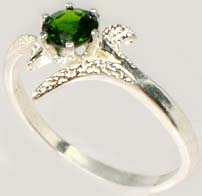
Diopside gemstones were certainly used in the ancient world, and have on occasion been uncovered by archaeologists, however few records exist as diopside was not identified as such, and was likely confused with other gemstones such as emerald. There was a tendency for all green gemstones in the ancient world to be identified as “emerald”. This tendency even persisted through the Renaissance. When “chrome tourmaline”, a similarly colored green gemstone was discovered in the seventeenth century by German miners in Brazil, it was enthusiastically received in Europe as “Brazilian Emerald”. Many years passed before it was realized that the “emerald” from Brazil was not, in fact, emerald.
You can imagine with so many sources within what was the classical world (Italy’s Mount Vesuvius, Switzerland, Austria, Norway, Macedonian Greece, Finalnd, Poland, Czechoslovakia, France, etc.), chrome diopside must have been known in the ancient world, even if not widely. So it is almost certain that chrome diopside, though known in the ancient world, must have been misidentified with emerald. Most sources record that the first (“ever”) discovery of chrome diopside was in Siberia, Russia in 1988. Actually, those commonly perceived “facts” are wrong on both accounts. Chrome diopside was not first discovered in Siberia, Russia; and when it was discovered in Siberia, it was actually much earlier than 1988. First, even Russian sources acknowledge that when chrome diopside was discovered in Siberia, it had already been discovered centuries earlier.
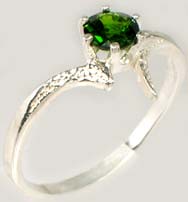
Even according to (other) Russian sources, chrome diopside was first found in Italy at the River Ala in the Mussa Valley. The gemstone was known to the Italians as “alalit” (referring to the “Ala” River), or “mussit” (referring to the Mussa Valley or the Italian “Mussa” Alps). There are published references to both mussit and alalit in European sources dating at least as far back as the 1700’s. There are also references to the same gemstone, chrome diopside, as “baikalit”, so named for another source known hundreds of years ago, also in Siberia, Russia, near Lake Baikal (and thus the gemstone was named “baikalit”). And there’s yet another source referred to in European literature of the 1700’s known as “malacolit”, which was found in Finland.
So chrome diopside was not new even to Russians when the deposits presently the source of the majority of the world’s gemstone quality material was discovered in the twentieth century. It had been known centuries before from deposits around Lake Baikal. And even when the present production source was discovered, it was actually discovered well before 1988. It was actually discovered in 1968 by one “Anatoli Mihalovich Korchagin”, who analyzed the gemstone and published his findings as part of his doctoral dissertation within Russia. Mining of the gemstone actually started in 1972, however descriptions of the discovery were not published internationally until 1988, and it was in 1988 that chrome diopside was “discovered” by sources in Western Europe and America. .
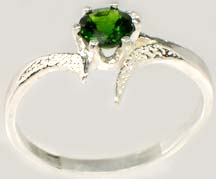
However it was in 1968 when the gemstone was discovered near the city of Aldan, on the Inagli River, and so the gemstone is oftentimes referred to in Russian Literature as “inaglit”. In Russia it is more frequently referred to as “Siberian Emerald” or “Yakutsk Emerald” (oftentimes incompletely spelled as “Yakut Emerald” in English-language publications). Recently some Russian producers are trying to use a more marketable name for chrome diopside, now calling it “vertelite”, after the Greek “vert” (for green) and “lite” (for stone). Nonetheless chrome diopside is most commonly referred to as “Yakutsk Emerald” in Russia, so named as the city of Yakutsk is the nearest major city in relation to the source of the gemstone, and it is into that city that the rough crystals are transported after being mined.
Yakutsk is the capital city of the Sakha Republic of Russia, located about 450 kilometers (280 miles) south of the Arctic Circle. Yakutsk is a major port on the Lena River. It is actually best known as being a major supplier of Siberian diamonds. Yakutsk was founded as a fort in 1632, and in 1639 it became the center of the province. Yakutsk is one of the destinations of the Siberian Lena Highway. The city's connection to the highway is only accessible by ferry in the summer, or in the dead of winter, directly over the frozen Lena River, as Yakutsk lies entirely on its western bank, and there is no bridge anywhere in the Sakha Republic that crosses the Lena. The river is impassable for long periods of the year when it is full of loose ice, or when the ice cover is not sufficiently thick to support traffic, or when the water level is high and the river turbulent with spring flooding.
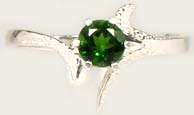
Throughout the history of the ancient world, gemstones were believed capable of curing illness, possessed of valuable metaphysical properties, and to provide protection. Found in Egypt dated 1500 B. C., the "Papyrus Ebers" offered one of most complete therapeutic manuscripts containing prescriptions using gemstones and minerals. Gemstones were not only valued for their medicinal and protective properties, but also for educational and spiritual enhancement. Under what name chrome diopside was known in the ancient world is indeterminable. It was likely misidentified as emerald. It is almost certain that chrome diopside was known in the ancient world, particularly considering that the sources of the gemstone include Mount Vesuvius, the famous volcano which buried Pompeii and Herculaneum.
Found also in Macedonian Greece, nonetheless chrome diopside was not identified in ancient literature, at least by a name which we would recognize as referring specifically to chrome diopside. So history is silent as to how transparent chrome diopside crystals may have been used for healing or for mystic or shamanic purposes. However it is possible that the beliefs which modern practitioners hold pertaining to diopside crystals may reflect more ancient beliefs. It is common for such beliefs to be carried forward in folklore. It’s perhaps of particular relevance to examine Russian folklore pertaining to the gemstone’s attributes and history. According to Russian folklore, “once upon a time”, a long time ago, a god was flying above Yakutsk (the North Ural Mountains) during a blizzard.
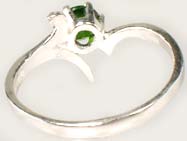
The blizzard was so cold that the god’s hands became frozen, causing him to drop a bag of gemstones which fell over the Siberian mountains and tundra. The gemstones of course were chrome diopside. In Russian folk medicine, wearing chrome diopside as an amulet is believed to prepare the body for heavy medications, predisposing the body to absorb the medications more completely and without side effects. It is also believed that worn near the heart as a pendant, chrome diopside is very good for relieving stress, but it is cautioned that if worn too frequently, it will relieve stress to the point where the opposite occurs, the wearer is so relaxed they slip into listlessness and then emotional depression.
In Russia chrome diopside is also credited with bringing overall good health to the wearer, and is regarded as useful for relieving tired eyes. Metaphysically it is said to bestow the wearer with a feeling of freedom and hopefulness. There are even specific prescriptions for the wearing of chrome diopside in the folklore of Russia. Worn on the left hand, set into silver, it is said to be an aid to preventing or recovering from diseases involving the lungs and respiratory system. Worn on the right hand and set in gold, it is said to have a beneficial effect on stomach and digestive disorders. Finally, when worn on the left hand, it is said to engender a more appealing personality for the wearer, and is so recommended to wear on dates and on job interviews.

Though there is not a great deal of literature in American sources pertaining to the medicinal and metaphysical uses for “crystal healing” using chrome diopside, there are some contemporary sources suggest that chrome dipside will aid in the development of the intellectual and analytical skills of the wearer, and to enhance mental clarity. It also said to provide protection from evil and bad memories. Meditation with diopside is said to unlock the secrets of the wearers mind and to help them better understand their innermost self. It is also said to be a helpful stone for magicians and spiritual seekers, revealing the mysterious magic and sacred power of everyday people, places and things that might otherwise be overlooked. It is also said to benefit some sufferers of chronic diseases of respiratory and circulatory systems, and is also said to benefit wearers of the gemstone by cleansing their organs.
HISTORY OF SILVER: After gold, silver is the metal most widely used in jewelry and the most malleable. The oldest silver artifacts found by archaeologists date from ancient Sumeria about 4,000 B.C. At many points in the ancient world, it was actually more costly than gold, particularly in ancient Egypt. Silver is found in native form (i.e., in nuggets), as an alloy with gold (electrum), and in ores containing sulfur, arsenic, antimony or chlorine. Much of the silver originally found in the ancient world was actually a natural alloy of gold and silver (in nugget form) known as “electrum”.

The first large-scale silver mines were in Anatolia (ancient Turkey) and Armenia, where as early as 4,000 B.C. silver was extracted from lead ores by means of a complicated process known as “smelting”. Even then the process was not perfect, as ancient silver does contain trace elements, typically lead, gold, bismuth and other metals, and as much as a third of the silver was left behind in the slag. However measuring the concentrations of the “impurities” in ancient silver can help the forensic jewelry historian in determining the authenticity of classical items. From Turkey and Armenia silver refining technology spread to the rest of Asia Minor and Europe.
By about 2,500 B.C. the Babylonians were one of the major refiners of silver. Silver “treasures” recovered by archaeologists from the second and third millenniums demonstrate the high value the ancient Mediterranean and Near East placed upon silver. Some of the richest burials in history uncovered by archaeologists have been from this time frame, that of Queen Puabi of Ur, Sumeria (26th century B.C.); Tutankhamun (14th century B.C.), and the rich Trojan (25th century B.C.) and Mycenaean (18th century B.C.) treasures uncovered by Heinrich Schliemann.

The ancient Egyptians believed that the skin of their gods was composed of gold, and their bones were thought to be of silver. When silver was introduced into Egypt, it probably was more valuable than gold (silver was rarer and more valuable than gold in many Mesoamerican cultures as well). In surviving inventories of valuables, items of silver were listed above those of gold during the Old Kingdom. Jewelry made of silver was almost always thinner than gold pieces, as indicated by the bracelets of the 4th Dynasty (about 2,500 B.C.) Queen Hetephere I, in marked contrast to the extravagance of her heavy gold jewelry.
A silver treasure excavated by archaeologists and attributable to the reign of Amenemhat II who ruled during the 12th Dynasty (about 1900 B.C.), contained fine silver items which were actually produced in Crete, by the ancient Minoans. When the price of silver finally did fall due to more readily available supplies, for at least another thousand years (through at least the 19th dynasty, about 1,200 B.C.) the price of silver seems to have been fixed at half that of gold. Several royal mummies attributable to about 1,000 B.C. were even entombed in solid silver coffins.

Around 1,000 B.C. Greek Athenians began producing silver from the Laurium mines, and would supply much of the ancient Mediterranean world with its silver for almost 1,000 years. This ancient source was eventually supplemented around 800 B.C. (and then eventually supplanted) by the massive silver mines found in Spain by the Phoenicians and their colony (and ultimate successors) the Carthaginians (operated in part by Hannibal’s family). With the defeat of Carthage by Rome, the Romans gained control of these vast deposits, and mined massive amounts of silver from Spain, stripping entire forests regions for timber to fuel smelting operations. In fact, it was not until the Middle Ages that Spain’s silver mines (and her forests) were finally exhausted.
Although known during the Copper Age, silver made only rare appearances in jewelry before the classical age. Despite its infrequent use as jewelry however, silver was widely used as coinage due to its softness, brilliant color, and resistance to oxidation. Silver alloyed with gold in the form of “electrum” was coined to produce money around 700 B.C. by the Lydians of present-day Turkey. Having access to silver deposits and being able to mine them played a big role in the classical world. Actual silver coins were first produced in Lydia about 610 B.C., and subsequently in Athens in about 580 B.C.

Many historians have argued that it was the possession and exploitation of the Laurium mines by the Athenians that allowed them to become the most powerful city state in Greece. The Athenians were well aware of the significance of the mining operations to the prosperity of their city, as every citizen had shares in the mines. Enough silver was mined and refined at Laurium to finance the expansion of Athens as a trading and naval power. One estimate is that Laurium produced 160 million ounces of silver, worth six billion dollars today (when silver is by comparison relatively cheap and abundant). As the production of silver from the Laurium mines ultimately diminished, Greek silver production shifted to mines in Macedonia.
Silver coinage played a significant role in the ancient world. Macedonia’s coinage during the reign of Philip II (359-336 B.C.) circulated widely throughout the Hellenic world. His famous son, Alexander the Great (336-323 B.C.), spread the concept of coinage throughout the lands he conquered. For both Philip II and Alexander silver coins became an essential way of paying their armies and meeting other military expenses. They also used coins to make a realistic portrait of the ruler of the country. The Romans also used silver coins to pay their legions. These coins were used for most daily transactions by administrators and traders throughout the empire.

Roman silver coins also served as an important means of political propaganda, extolling the virtues of Rome and her emperors, and continued in the Greek tradition of realistic portraiture. As well, many public works and architectural achievements were also depicted (among them the Coliseum, the Circus Maximus). In addition many important political events were recorded on the coinage. Roman coins depicted the assassination of Julius Caesar, alliances between cities, between emperors, between armies, etc. And many contenders for the throne of Rome are known only through their coinage.
Silver was also widely used as ornamental work and in other metal wares. In ancient cultures, especially in Rome, silver was highly prized for the making of plate ware, household utensils, and ornamental work. The stability of Rome’s economy and currency depended primarily on the output of the silver mines in Spain which they had wrested from the Carthaginians. In fact many historians would say that it was the control of the wealth of these silver mines which enabled Rome to conquer most of the Mediterranean world. When in 55 B.C. the Romans invaded Britain they were quick to discover and exploit the lead-silver deposits there as well.

Only six years later they had established many mines and Britain became another major source of silver for the Roman Empire. It is estimated that by the second century A.D., 10,000 tons of Roman silver coins were in circulation within the empire. That’s about 3½ billion silver coins (at the height of the empire, there were over 400 mints throughout the empire producing coinage). That’s ten times the total amount of silver available to Medieval Europe and the Islamic world combined as of about 800 A.D. Silver later lost its position of dominance to gold, particularly in the chaos following the fall of Rome. Large-scale mining in Spain petered out, and when large-scale silver mining finally resumed four centuries after the fall of Rome, most of the mining activity was in Central Europe.
By the time of the European High Middle Ages, silver once again became the principal material used for metal artwork. Huge quantities of silver from the New World also encouraged eager buyers in Europe, and enabled the Spanish to become major players in the late Medieval and Renaissance periods. Unlike the ores in Europe which required laborious extraction and refining methods to result in pure silver, solid silver was frequently found as placer deposits in stream beds in Spain’s “New World” colonies, reportedly in some instances solid slabs weighing as much as 2,500 pounds. Prior to the discovery of massive silver deposits in the New World, silver had been valued during the Middle Ages at about 10%-15% of the value of gold.

In 15th century the price of silver is estimated to have been around $1200 per ounce, based on 2010 dollars. The discovery of massive silver deposits in the New World during the succeeding centuries has caused the price to diminish greatly, falling to only 1-2% of the value of gold. The art of silver work flourished in the Renaissance, finding expression in virtually every imaginable form. Silver was often plated with gold and other decorative materials. Although silver sheets had been used to overlay wood and other metals since ancient Greece, an 18th-century technique of fusing thin silver sheets to copper brought silver goods called Sheffield plate within the reach of most people.
At the same time the use of silver in jewelry making had also started gaining popularity in the 17th century. It was often as support in settings for diamonds and other transparent precious stones, in order to encourage the reflection of light. Silver continued to gain in popularity throughout the 18th and 19th centuries, and by the 20th century competed with gold as the principal metal used in the manufacture of jewelry. Silver has the highest thermal and electrical conductivity of any metal, and one of the highest optical reflectivity values. It has a brilliant metallic luster, is very ductile and malleable, only slightly harder than gold, and is easily worked and polished.

When used in jewelry, silver is commonly alloyed to include 7.5% copper, known as “sterling silver”, to increase the hardness and reduce the melting temperature. Silver jewelry may be plated with 99.9% pure ‘Fine Silver’ to increase the shine when polished. It may also be plated with rhodium to prevent tarnish. Virtually all gold, with the exception of 24 carat gold, includes silver. Most gold alloys are primarily composed of only gold and silver. Throughout the history of the ancient world, gemstones were believed capable of curing illness, possessed of valuable metaphysical properties, and to provide protection. Found in Egypt dated 1500 B. C., the "Papyrus Ebers" offered one of most complete therapeutic manuscripts containing prescriptions using gemstones and minerals.
Gemstones were not only valued for their medicinal and protective properties, but also for educational and spiritual enhancement. Precious minerals were likewise considered to have medicinal and “magical” properties in the ancient world. In its pure form silver is non toxic, and when mixed with other elements is used in a wide variety of medicines. Silver ions and silver compounds show a toxic effect on some bacteria, viruses, algae and fungi. Silver was widely used before the advent of antibiotics to prevent and treat infections, silver nitrate being the prevalent form. Silver Iodide was used in babies' eyes upon birth to prevent blinding as the result of bacterial contamination.

Silver is still widely used in topical gels and impregnated into bandages because of its wide-spectrum antimicrobial activity. The recorded use of silver to prevent infection dates to ancient Greece and Rome. Hippocrates, the ancient (5th century B.C.) Greek "father of medicine" wrote that silver had beneficial healing and anti-disease properties. The ancient Phoenicians stored water, wine, and vinegar in silver bottles to prevent spoiling. These uses were “rediscovered” in the Middle Ages, when silver was used for several purposes; such as to disinfect water and food during storage, and also for the treatment of burns and wounds as a wound dressing.
The ingestion of colloidal silver was also believed to help restore the body's “electromagnetic balance” to a state of equilibrium, and it was believed to detoxify the liver and spleen. In the 19th century sailors on long ocean voyages would put silver coins in barrels of water and wine to keep the liquid potable. Silver (and gold) foil is also used through the world as a food decoration. Traditional Indian dishes sometimes include the use of decorative silver foil, and in various cultures silver dragée (silver coated sugar balls) are used to decorate cakes, cookies, and other dessert items. [AncientGifts].

SHIPPING & RETURNS/REFUNDS: Your purchase will ordinarily be shipped within 48 hours of payment. We package as well as anyone in the business, with lots of protective padding and containers. All of our shipments are fully insured against loss, and our shipping rates include the cost of this coverage (through stamps.com, Shipsaver.com, the USPS, UPS, or Fed-Ex). International tracking is provided free by the USPS for certain countries, other countries are at additional cost. ADDITIONAL PURCHASES do receive a VERY LARGE discount, typically about $5 per item so as to reward you for the economies of combined shipping/insurance costs. We do offer U.S. Postal Service Priority Mail, Registered Mail, and Express Mail for both international and domestic shipments, as well United Parcel Service (UPS) and Federal Express (Fed-Ex). Please ask for a rate quotation. We will accept whatever payment method you are most comfortable with.
Please note for international purchasers we will do everything we can to minimize your liability for VAT and/or duties. But we cannot assume any responsibility or liability for whatever taxes or duties may be levied on your purchase by the country of your residence. If you don’t like the tax and duty schemes your government imposes, please complain to them. We have no ability to influence or moderate your country’s tax/duty schemes. If upon receipt of the item you are disappointed for any reason whatever, I offer a no questions asked 30-day return policy. Send it back, I will give you a complete refund of the purchase price; 1) less our original shipping/insurance costs, 2) less any non-refundable eBay fees. Please note that though they generally do, eBay may not always refund payment processing fees on returns beyond a 30-day purchase window. So except for shipping costs and any payment processing fees not refunded by eBay, we will refund all proceeds from the sale of a return item. Obviously we have no ability to influence, modify or waive eBay policies.
ABOUT US: Prior to our retirement we used to travel to Eastern Europe and Central Asia several times a year seeking antique gemstones and jewelry from the globe’s most prolific gemstone producing and cutting centers. Most of the items we offer came from acquisitions we made in Eastern Europe, India, and from the Levant (Eastern Mediterranean/Near East) during these years from various institutions and dealers. Much of what we generate on Etsy, Amazon and Ebay goes to support worthy institutions in Europe and Asia connected with Anthropology and Archaeology. Though we have a collection of ancient coins numbering in the tens of thousands, our primary interests are ancient/antique jewelry and gemstones, a reflection of our academic backgrounds.
Though perhaps difficult to find in the USA, in Eastern Europe and Central Asia antique gemstones are commonly dismounted from old, broken settings – the gold reused – the gemstones recut and reset. Before these gorgeous antique gemstones are recut, we try to acquire the best of them in their original, antique, hand-finished state – most of them originally crafted a century or more ago. We believe that the work created by these long-gone master artisans is worth protecting and preserving rather than destroying this heritage of antique gemstones by recutting the original work out of existence. That by preserving their work, in a sense, we are preserving their lives and the legacy they left for modern times. Far better to appreciate their craft than to destroy it with modern cutting.
Not everyone agrees – fully 95% or more of the antique gemstones which come into these marketplaces are recut, and the heritage of the past lost. But if you agree with us that the past is worth protecting, and that past lives and the produce of those lives still matters today, consider buying an antique, hand cut, natural gemstone rather than one of the mass-produced machine cut (often synthetic or “lab produced”) gemstones which dominate the market today. We can set most any antique gemstone you purchase from us in your choice of styles and metals ranging from rings to pendants to earrings and bracelets; in sterling silver, 14kt solid gold, and 14kt gold fill. When you purchase from us, you can count on quick shipping and careful, secure packaging. We would be happy to provide you with a certificate/guarantee of authenticity for any item you purchase from us. There is a $3 fee for mailing under separate cover. I will always respond to every inquiry whether via email or eBay message, so please feel free to write.
